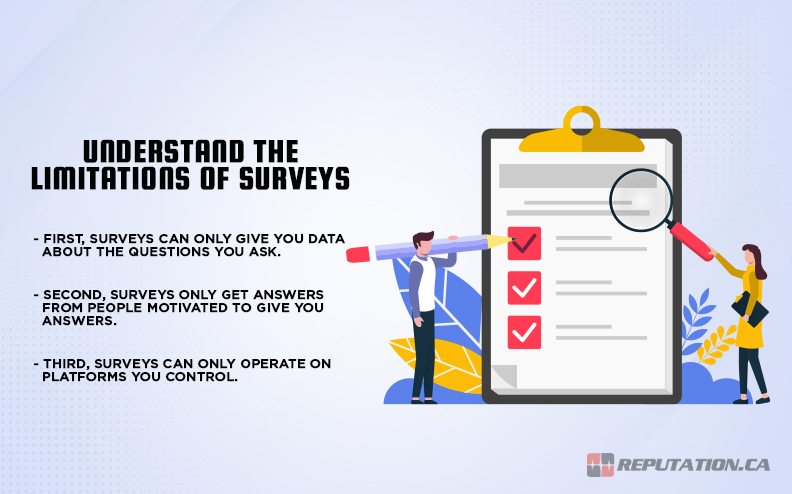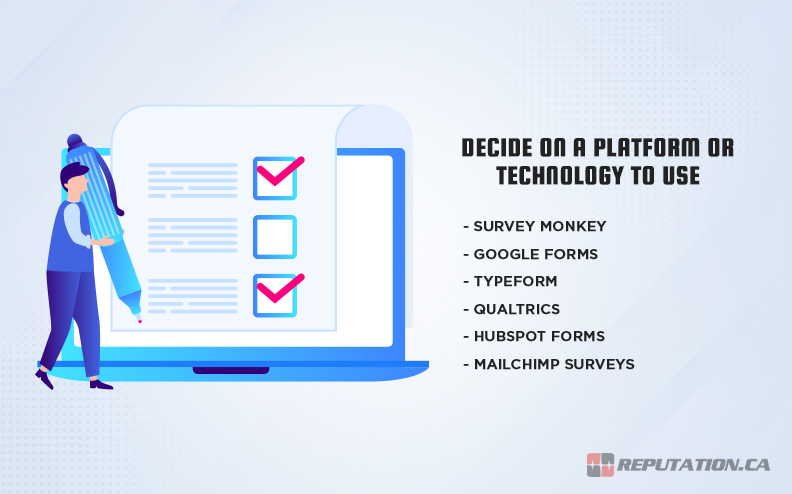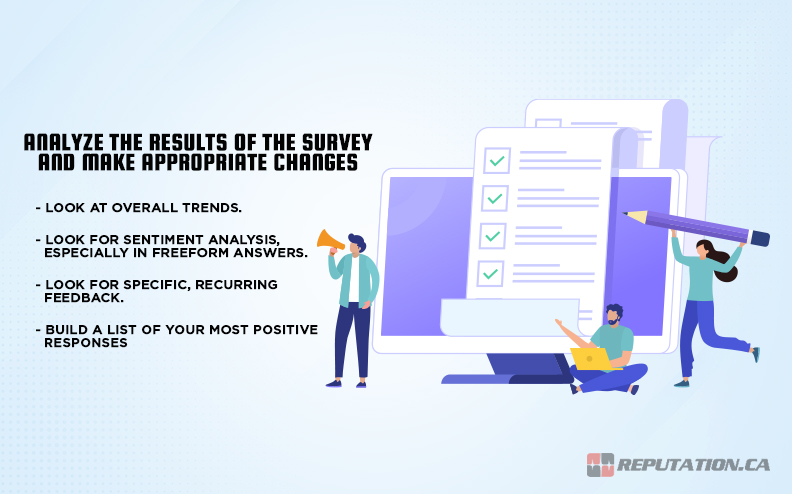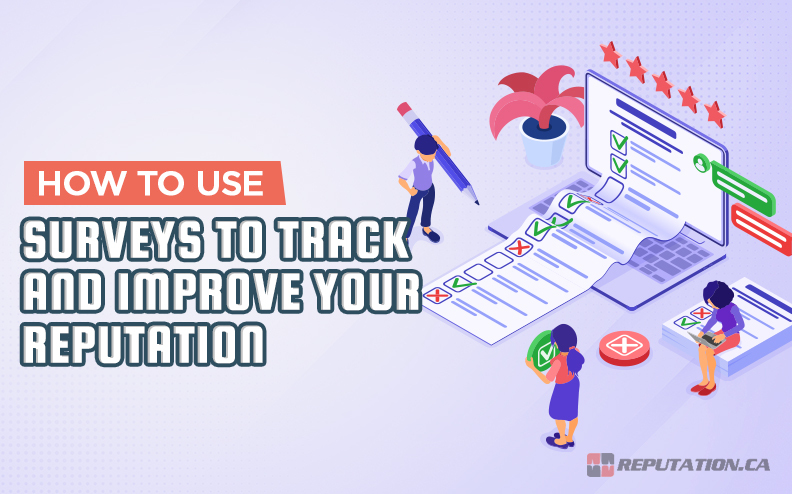In marketing and business optimization, we all often talk about metrics and data. We use highly advanced analytics platforms to track user behavior, heat maps and session tracking to monitor how users are navigating sites, purchase behavior and engagement actions to monitor sentiment… the list never ends. It’s easy to end up swamped under hundreds, if not thousands, of different data points. All with one goal in mind: to understand how users view and interact with your company.
There’s just one thing we often overlook. Have you ever tried just asking them?
The truth is, one of the best ways to get feedback and information about your business reputation and how you’re perceived by your audience is to simply ask them. Direct feedback via surveys is a powerful tool. The question is, how do you use them appropriately?
Understand What Surveys Can Do
Surveys can be a very powerful tool for receiving feedback from your community. You can implement them in a variety of different locations, harvest data about any topic you can think to ask about, and use the data you get to make decisions to optimize future efforts.

For example:
- A survey asking why a user cancels a subscription can help you identify a pain point that needs a fix.
- A survey asking what the user likes and dislikes about your brand can give you insight into your overall reputation.
- A simple survey asking how a user would rate your service can build you a list of satisfied users to ask for testimonials later.
It’s important to remember that a survey is just a tool. It’s nothing more than a form you give your audience to fill out; the utility and the data you get out of it is entirely determined by the questions you ask, how you ask them, and where you ask them.
Understand the Limitations of Surveys
Before we get into ways you can use surveys to work on your company’s reputation; it’s important to acknowledge that surveys have three major limitations.

First, surveys can only give you data about the questions you ask. At its core, a survey is just a form. You can put anything you want in the form, from a star rating to an open-ended text box. Surveys can be one question long or three pages of questions long. They’re entirely free-form, so they can only give you information you ask for. That means a huge part of the process of using surveys is figuring out what you want to use them to do.
Second, surveys only get answers from people motivated to give you answers. A huge portion of your users just don’t care to fill out a survey. There are all manner of roadblocks that can keep them from giving you answers, too. Maybe you give them the survey at the wrong time. Maybe the survey is too open-ended, and they don’t want to think about feedback right now. Maybe they have nothing really noteworthy to say. Maybe the survey has a few too many questions, and they don’t want to fill out the whole thing. Without some kind of motivation – either strong emotions or an incentive – they aren’t going to fill it out.
Third, surveys can only operate on platforms you control. You can hand out a survey through a website pop-up, a window inside your software, or a widget inside your email newsletter. You can’t send a survey to people who leave you reviews on Yelp, or people who comment on a post about you on a news site, or whatever else. You’re limited in your access to only people you can already access through other means.
Surveys are great, but they aren’t 100% accurate. They are inherently biased by the audience they reach, and you may need to take that into account. It’s distressingly easy for a vocal minority to skew the direction of a business simply because the majority of people don’t care enough to leave feedback to the contrary.
Surveys for Reputation Management
We’re a reputation management firm, so of course, we’re going to look at surveys in the context of reputation management. There are all kinds of other uses – marketing, feedback, keyword research, product research – but they’re discussed plenty elsewhere.
Generally, surveys can do three things for you for reputation management.

Surveys can give you an idea of what your audience thinks of your brand outside of traditional review channels. Remember, reviews are generally only left by people who are already brand advocates or people who are broadly dissatisfied and want to cajole or blackmail you into taking action to help them.
There’s a huge swath of users in the middle, who don’t necessarily feel strongly enough to leave a review, but who have thoughts and opinions they might be willing to share via a short survey. Since these people make up the bulk of your users, they can be a very important audience to tap for information.
Surveys can point out problems or issues that need resolving, so they don’t hurt your reputation. Whether this is as simple as a downward trend in overall reviews or as complex as a specific point of failure in your product, a problem employee causing issues, or a beloved feature you decided to remove, this kind of feedback is critical.
All too often, companies alter their products or services with an aim towards short-term profit. Or, they make changes based on the opinions of a few executives or people who have bought into the Next Big Thing, without regard for how it appears to their greater audience. You need look no further than the massive list of companies buying into Crypto and NFTs, only to backpedal when massive numbers of their audience start canceling services and taking to social media to bomb them, to see how this plays out.
Surveys can provide you with a list of people who can give you positive testimonials. A survey asking how people feel allows them to give you feedback through a private channel, one with a lower bar and barrier to entry than leaving a review on a site like Google or Yelp. Most of them will likely be middling to positive and may have some useful feedback for you. What you’re looking for, though, are the people who leave 5-star positive reviews.
These people can be tracked (easily, if you ask who they are in the survey), and you can ask them later via email if they’re willing to expand their review into a testimonial, either for use on your site or for posting on Google. You can read more about how to actually do that here.
How to Use Surveys Appropriately
If you want to use surveys to improve your reputation, you have a lot of options available to you. Luckily, while it’s complex, we can guide you through the process. Here’s a guide you can follow, adapting to your own situation as you go.
Determine what, exactly, you want to get out of your survey.

The first thing you need to do is decide on an objective for your surveys. This can be as simple as “ask for a 1–5-star rating to gauge overall sentiment” to “get specific feedback on a narrow feature of the core product” and everything in between. Pinning down the purpose of the survey is critical to the process of setting up your surveys because it can determine virtually everything that comes after. Everything from the technology you use to the questions you ask can change depending on the purpose of your questions.
Determine when and where to show a survey.
Once you know what you want to ask, you can start to think about who you want to ask. For example, if you want a general star rating, you should put your survey on every page of your website, probably as a timed slider to capture the people who don’t immediately bounce, and ask them the simple question. If you want more in-depth feedback on a specific product, put the survey on the product page, service page, or usage guide page. The more narrow and in-depth the information you’re asking for, the narrower the display should be, because otherwise, you’ll be showing the survey to too-broad of an audience.

Don’t forget other channels. Surveys can be embedded into apps, software, SMS messaging, and email newsletters, and can even be printed out as part of marketing materials, in products you ship out, and for in-store flyers. Surveys don’t have to be purely digital; just remember that a physical survey requires data entry to collate the information.
Decide on a platform or technology to use.
There are all sorts of different apps and platforms you can use for surveys. The one you choose depends a lot on your overall purpose (and budget) so, rather than offer recommendations, we’re just going to offer options for you to look into.

Some of these options include:
- Survey Monkey, one of the most common and prolific survey platforms.
- Google Forms, which is free to start and works great for longer surveys.
- Typeform, one of the most robust and flexible form and survey apps.
- Qualtrics, a business-class feedback engine meant for larger companies.
- HubSpot Forms, a feature you already have if you use HubSpot as a CRM.
- Mailchimp Surveys, a feedback feature for newsletters built into Mailchimp.
These are, of course, just a few of the options available to you. Depending on where you want to put your surveys, you may need something else or more than one of these at once.
Determine if the survey needs an incentive to encourage responses.

The longer and more complex a survey is, the more personal the information you ask for, or if you need to send a user off-site or off-track to take the survey, the more likely you are to want to add an incentive. Incentives can be anything from a discount code to a coupon to entry into a prize drawing; they don’t need to be complex or valuable, just something more than “the pleasant feeling of knowing you’ve contributed to our market research.”
Create and implement the survey to harvest data.

Creating your survey is, obviously, a key part of the process. You may need to consult with a talented writer or a data analyst to make sure your questions can’t be misinterpreted and that you’re actually asking the questions you want to ask. You might also consider split testing different ways of asking your questions to see which ones get the most responses. Harvesting data like this is going to be a long and ongoing process, after all.
Analyze the results of the survey and make appropriate changes.
Once you’ve run your survey for a while, you can analyze your data.

How do you do this?
- Look at overall trends. Are people generally rating you higher or lower, and how does this compare to your reputation on public forums and review sites?
- Look for sentiment analysis, especially in freeform answers. There are many sentiment analysis apps you can use to analyze text.
- Look for specific, recurring feedback. If dozens of people are pointing out one feature they love or hate, and how they feel about it coming or going away, this can indicate a change you need to make.
- Build a list of your most positive responses and contact those people for further testimonials later.
Surveys are, at the end of the day, just a way to get you more data and insight into the opinions of your audience. Whether you’re identifying and addressing problems, identifying issues and cutting them off at the pass, or just using it as a tool to solicit more positive reviews, surveys can be as powerful as you let them be. They do, however, need you to appropriately harvest and interpret the data you receive. Make sure to put it all into context, otherwise, you might miss the forest for the trees.
If you ever have any questions or concerns about surveys, how to interpret their data, or what they can do for your company, please feel free to contact us at any time! As mentioned, using surveys properly isn’t always a simple task for every business or company, so we would love to assist you with that process however we can.











